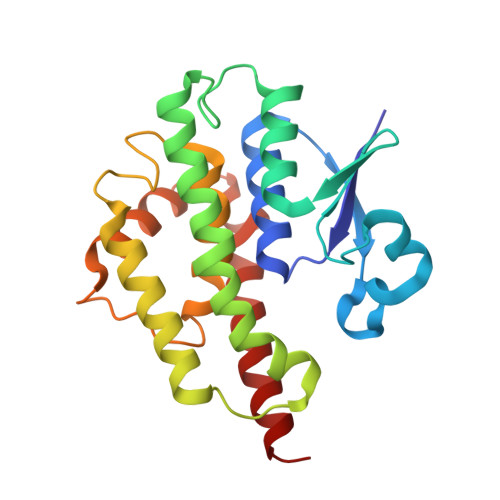Structure of an insect epsilon class glutathione S-transferase from the malaria vector Anopheles gambiae provides an explanation for the high DDT-detoxifying activity
Wang, Y., Qiu, L., Ranson, H., Lumjuan, N., Hemingway, J., Setzer, W.N., Meehan, E.J., Chen, L.(2008) J Struct Biol 164: 228-235
- PubMed: 18778777
- DOI: https://doi.org/10.1016/j.jsb.2008.08.003
- Primary Citation of Related Structures:
2IL3, 2IMI, 2IMK - PubMed Abstract:
Glutathione S-transferases (GSTs), a major family of detoxifying enzymes, play a pivotal role in insecticide resistance in insects. In the malaria vector Anopheles gambiae, insect-specific epsilon class GSTs are associated with resistance to the organochlorine insecticide DDT [1,1,1-trichloro-2,2-bis-(p-chlorophenyl)ethane]. Five of the eight class members have elevated expression levels in a DDT resistant strain. agGSTe2 is considered the most important GST in conferring DDT resistance in A. gambiae, and is the only member of the epsilon class with confirmed DDT-metabolizing activity. A delta class GST from the same species shows marginal DDT-metabolizing activity but the activity of agGSTe2 is approximately 350x higher than the delta class agGST1-6. To investigate its catalytic mechanism and the molecular basis of its unusually high DDT-metabolizing ability, three agGSTe2 crystal structures including one apo form and two binary complex forms with the co-factor glutathione (GSH) or the inhibitor S-hexylglutathione (GTX) have been solved with a resolution up to 1.4A. The structure of agGSTe2 shows the canonical GST fold with a highly conserved N-domain and a less conserved C-domain. The binding of GSH or GTX does not induce significant conformational changes in the protein. The modeling of DDT into the putative DDT-binding pocket suggests that DDT is likely to be converted to DDE [1,1-dichloro-2,2-bis-(p-chlorophenyl)ethylene] through an elimination reaction triggered by the nucleophilic attack of the thiolate group of GS(-) on the beta-hydrogen of DDT. The comparison with the less active agGST1-6 provides the structural evidence for its high DDT-detoxifying activity. In short, this is achieved through the inclination of the upper part of H4 helix (H4'' helix), which brings residues Arg112, Glu116, and Phe120 closer to the GSH-binding site resulting in a more efficient GS(-)-stabilizing hydrogen-bond-network and higher DDT-binding affinity.
- Laboratory for Structural Biology, Department of Chemistry, Graduate Program of Biotechnology, University of Alabama in Huntsville, Huntsville, AL 35899, USA.
Organizational Affiliation:

















